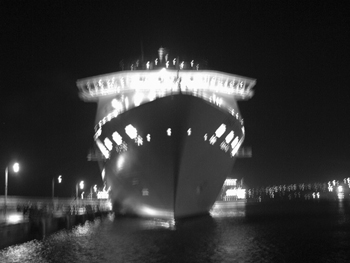![[Metroactive News&Issues]](/gifs/news468.gif)
[ Santa Cruz Week | SantaCruz Home | Archives ]
Troubled Waters
Environmentalists are sending out an SOS as a new wave of luxury liners gets set to anchor in the Monterey Bay Sanctuary
By Rebecca Patt
Eat your heart out, Sebastian Vizcaino. That feisty Spaniard may have been the first non-California native to barge into our local waters when he arrived in 1602 on the way to the shores he would name "Monterey," but the guy knew nothing about traveling in style.
These days, the boats looking to anchor in the Monterey Bay National Marine Sanctuary weigh 77,713 tons, measure 866 feet long and carry 1,870 passengers and a crew of 800. Guests can frolic in three swimming pools, view a multimillion-dollar art collection, watch first-run movies in a large theater and eat in a two-story dining room with floor-to-ceiling windows, white-glove service and five-course meals.
And as the boom in the cruise ship industry ripples into our protected waters, these luxury liners are planning to stop at a record rate. The Celebrity Cruise ship Mercury is scheduled to make 13 stops this year in Monterey as it voyages along the California coast and to Mexico, leaving from and returning to San Francisco. Last year, Monterey Bay was visited by three cruise ships, and before that, any large cruise liners visiting the bay were few and far between.
But as the first of these new waves of visitors prepares to embark on March 15, environmental groups are speaking out about the impact the ship will have on the Monterey Bay's water, air quality and fragile marine life. The sanctuary is one of the most diverse marine ecosystems in the world, teeming with unique and endangered species. And critics say it is facing a serious threat in the form of these "floating cities," which produce large volumes of oil-contaminated waste, garbage, gray water, sewage water, and toxic wastes from activities such as dry cleaning, photo-processing and carpet cleaning.
Ross Klein, an industry watchdog and author of Cruise Ship Blues, has been making appearances locally to talk about the state of the cruise-ship industry in general and, more specifically, some of the dangers the new luxury-liner traffic poses to the environmentally sensitive Monterey Bay Sanctuary. In an interview with Metro Santa Cruz, Klein said pollution from cruise ships has the potential to be devastating to our local environment.
"Knowing how fragile the environment is in the Monterey Bay, people have to be concerned about cruise ships. The industry has been particularly unfriendly to the environment, and one has to watch what is going on and be prepared to speak up if there are problems," he says.
Come Aboard, They're Expecting You
The itinerary that brings the Mercury into Monterey Bay reflects a growing trend of deploying ships closer to major cities so that cruise ship companies can "get in people's backyards with the product," says Michael Bonner, vice president of corporate planning for Royal Caribbean Cruises Ltd., which owns Royal Caribbean International and Celebrity Cruises, the latter of which runs the Mercury. Each Mercury voyage includes eight-hour visits to Monterey and other ports of call (the company has not expressed interest in bringing passengers to Santa Cruz).
It's a strategy that appears to be working. Recent reports of widespread gastrointestinal ailments notwithstanding, more and more people are choosing to sail the seas aboard these floating resorts, where the days are advertised as filled with sunshine, luxurious pampering, bountiful food and lavish entertainment.
From 1980 to 2000, the number of cruise ship passengers in North America increased fivefold--from 1.4 million to almost 7 million, and is expected to keep growing.
"It reduces the expense for people because they don't have to buy an airline ticket," says Bonner. "It's a natural result of industry growth catalyzed a little bit by people not wanting to fly."
As a result, the number of ships in service is increasing dramatically, as well, with 14 new ships slated to go on maiden voyages this year.
At the same time, the ships themselves are becoming enormous. Cruise ships built before 1980 typically accommodated under 1,000 passengers, but since then they've expanded steadily. The largest ships afloat today belong to Royal Caribbean International--starting in 1999 with the introduction of the Voyager of the Seas, its 143,000-ton Eagle-class ships can carry more than 5,000 people.
Lots of people has meant lots of problems. Cruise lines project an image of environmental responsibility, but the truth is that up until fairly recently the industry's environmental record was flat-out atrocious.
Royal Caribbean International, the largest of the cruise ship corporations, has proven to be the worst offender. Although no major incidents have occurred in the last couple of years, the company racked up $33.5 million in fines for dozens of incidents occurring between 1994 and 2000 in which its ships were found to have routinely dumped oil-contaminated bilge water and other hazardous wastes directly into the sea. The company was taken to court in San Juan, Miami, New York City, Los Angeles and Anchorage.
"It was a dark period in our corporate history," says Capt. Bill Wright, senior vice president of safety and environment for Royal Caribbean Cruises. "We had a few individuals aboard the ships that were not following the company's policies and that's unfortunate, but today we are stellar performers."
Royal Caribbean has learned its lesson and cleaned up its act, Wright insists. They have invested millions of dollars into training and state-of-the-art wastewater treatment technology. He says the Mercury in particular has the best water treatment equipment available, to the extent that the end product is clean enough to be drinkable (he claims to have tasted it), and the state of Alaska allows this treated water to be discharged directly into its ports. Wright also notes that in 2002 the Coast Guard awarded Royal Caribbean's Celebrity Cruises the Admiral Benkert Award for "superior environmental operations."
"We feel we can stand up to the scrutiny now," says Wright. "We do everything we can do to protect the environment. I consider myself personally an environmentalist, and it really irks me that other so-called environmentalists don't give us credit where credit is due. The main story is that the industry has changed its ways dramatically."
According to Wright, the tens of thousands of commercial vessels operating in U.S. waters are more to blame these days for screwing up the environment than the 250 cruise liners. He says that Celebrity Cruises' environmental standards in the Monterey Bay will surpass the legal requirements.
As it successfully requested of the three cruise ship companies that visited the Monterey Bay in 2002, the Monterey City Council has asked Celebrity Cruises to promise in writing that it will not discharge any materials whatsoever into the Monterey Bay National Marine Sanctuary, even materials that are legal to discharge. Celebrity Cruises says it has a letter of response in the works.
The Green and the Blue
Nonetheless, local environmentalists say that government policies are inadequate for dealing with the influx of cruise ships, and they are scrambling to have stricter laws passed. National marine sanctuaries from Monterey to Key West to Maine are all struggling to keep up policywise with the industry's rapid growth, says Kaitlin Gaffney, California Central Coast program manager at the Ocean Conservancy.
Key West in particular has seen an invasion, with 800,000 cruise ship visitors in 2002 and a whopping 81 mammoth vessels parked in its waters this past December, according to the Miami Herald.
Several groups are now working to create no-discharge legislation for the Monterey Bat National Marine Sanctuary on two different levels: within the state, as the state governs the area within three miles from the coast, and in the federal government, which has the final authority on the National Marine Sanctuary beyond three miles from shore. The sanctuary stretches 320 miles, from the Marin Headlands to Cambria.
Gaffney says that at the encouragement of environmental groups the state Legislature created a task force in 2001 to look at the issue of cruise ship regulations, and its recommendations are to be released this June.
At the federal level, the MBNMS advisory council will vote Feb. 7 on a resolution to ban cruise ship discharges within the sanctuary. If it passes, the resolution will be considered for approval by the sanctuary office in Washington.
"We are certainly eager to get the no discharge policy put into law," says Gaffney. "The voluntary pieces are a good first step, but it's not enough."
Meanwhile, Monterey is getting ready to welcome more ships. But many community members are expressing fear of environmental disaster and skepticism about the economic benefits to the town.
"Anything that brings people into Monterey to see our town, that's terrific. As a tourism-based economy we want that exposure, but we want safe exposure," says Rick Johnson, executive director of the Old Monterey Business Association.
In the past, cruise passengers have not spent much money during their visit, says Johnson. Of the three ships that came through in 2002, one was unable to bring passengers to town at all due to choppy seas. The cruise ships rely on smaller boats called tenders to transport the passengers to a dock that leads straight to the Cannery Row tourist area.
"We had no problems with these other three visits," says Monterey harbormaster Steve Scheiblauer. "If they do pollute, they will burn some bridges and not be welcome back here ... I am hopeful they've learned that lesson and will be good stewards when they come here."
Copyright © Metro Publishing Inc. Maintained by Boulevards New Media.
![]()

Ross Klein's critiques of the industry have got locals singing the cruise ship blues.

Pirates of the Royal Caribbean
From the January 15-21, 2003 issue of Metro Santa Cruz.